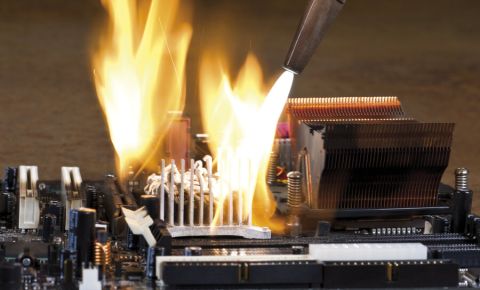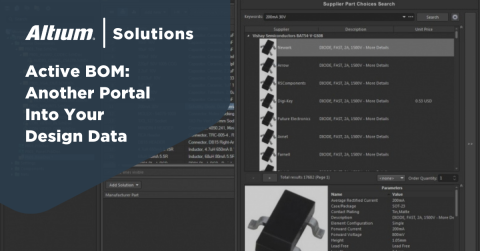Altium Designer® 18: Key Benefits of ActiveBOM – Webinar Recap - June 26th
ActiveBOM® provides a tool for getting real-time insight into the parts you need for your designs, and it supports “early and often” monitoring of your BOM to prevent manufacturing delays and setbacks. Additionally, it assists in identifying part choices that can be risky, such as the Not Recommended for New Design (NRFND) and End of Life (EOL) components shown in the demonstration. Best of all, it’s already part of Altium Designer 18 and there’s little to learn.
Watch the webinar video recording below or view the presentation slides if you were unable to attend the June 26th live ActiveBOM webinar.
Video:
If you prefer, you can review the ActiveBOM Key Webinar Highlights below:
Key Webinar Highlights
I briefly discussed some of the challenges design engineers encounter as they search for, select and source parts for designs. Then, I introduced ActiveBOM and provided a demonstration, followed by a summary and Q&A session (listed below).
Some Component Selection Challenges
It’s key to find the parts that support mission objectives, but there seems to always be a number of issues we encounter, including:
- Finding components that support project goals
- Early identification of at-risk components
- Coping with part shortages at build time
- Counterfeit part risks
- Environmental compliance
- Designing to cost
- Part lifecycle dynamics
Electronic components are like airline tickets – the availability and cost today is different than a month from today. Both are influenced by a variety of dynamic factors that change daily. Frequent, real-time monitoring can help to prevent component issues that can delay board manufacturing.
What is ActiveBOM?
ActiveBOM is an editor in Altium Designer that sits alongside, in importance, with the schematic and PCB editors. You can think of ActiveBOM as an alternative (table-based) way to view and interact with your design. The schematic provides the logical representation of the design and the PCB provides the physical representation. ActiveBOM supplements these two domains with focus on selection, sourcing and cost of the items needed to realize the PCB assembly in volume.
Advancing a design through manufacturing can be derailed if any of these three domains is compromised. You can have the most unique and high-performance design, but if you can’t get the parts at the right time and at the right cost, it’s an uphill battle. ActiveBOM provides designers with a strategic tool to proactively mitigate these issues.
ActiveBOM consumes data from a variety of sources, from global or cloud to on-premise or local, enabling users to optimize the BOM to meet project objectives. The BomDoc is a living project document that is design-aware. It updates in real time to any changes made to the design. Once your BOM is good to go, the BomDoc is the single-source for downstream outputs such as Draftsman® documents, BOM reports and output jobs. ActiveBOM supports any type of Altium libraries you have.
Overview of ActiveBOM Key UI Areas and Capabilities
Component List Table View
- Complete view of all BOM reflected from design with fully customizable column data/source, line item numbering schemes, reference designation grouping and saved views
- Displays BOM checks (configurable) for aspects such as availability, stocking suppliers, End of Life (EOL), Not Recommended for New Design (NRFND) and more
- Consolidated view displays complete BOM of design variants as well as fitted and unfitted status
- Cross probe directly from BOM reference designator to schematic and PCB
- Supports adding custom items such as custom/stocked parts, NRE costs, glue, mechanical parts, heatsink compound, etc.
Component Supply Chain Matrix
- Rank manufacturer part number (MPN) choices and view available supplier part numbers (SPN), stock, cost, minimum order quantity (MOQ) and price-breaks
- Solution tiles include one-click, direct links to manufacture datasheets and supplier websites
- Favorite suppliers can be defined and prioritized as desired
- Manual solutions can be added for internally stocked parts
Properties Panel
- Change production quantity for an immediate “what-if” analysis view of impact on price-per-board, target price achievement and resultant part choices and supplier part numbers
- View summary of BOM check errors and customize BOM checks
- Select and prioritize favorite suppliers and define BOM sets (saved views)
- Control column visibility and configure data sources
Questions and Answers
Q: The first time we tried to use ActiveBOM, a new Samtec connector we were using, that Samtec and Digi-Key showed as active and in full production, listed in ActiveBOM as "Not Recommended for New Designs". This really discouraged our organization from trusting ActiveBOM and the engineers have shied away from using ActiveBOM. We submitted a support ticket but never got a response. Can you please address this issue?
A: We have brought this issue to the attention of our support organization. Part of the improvement in performance is focused around a more efficient structuring, consolidation and indexing of Octopart. As these improvements have progressed, some issues, such as you mention, have been reported. We are working rapidly to remedy such situations. Please note that we provide an informative indication of lifecycle, not an authoritative indication. This indication is intended to be used as a reference, not as a conclusion.
Q: Where do you get the part solutions to start with?
A: ActiveBOM pulls the manufacturing part number solutions from your Altium component libraries, component instances in the design (those that include supplier or manufacturer links) and ActiveBOM manual solutions.
Q: Is there a method to add internal part numbers to the BOM?
A: Yes, just include the internal part number in your Altium library and that data can be selected for inclusion in the BomDoc. You can also include the custom part number directly in the BomDoc, but library-driven data will result in the most reuse and consistency, because it supports a “change once and update to many” philosophy.
Q: What formats could be used for internal stock? Let me rephrase my question. What formats of corporate databases could be used with ActiveBOM?
A: Any database which provides OLE DB support can be accessed. Some databases may not offer OLE DB support. However, virtually all Database Management Systems in use today can be accessed through the Open Database Connectivity (ODBC) interface. For additional detail, please refer to this Altium documentation link. If you are using Altium Vault as your central component library, the part catalog may be the more appropriate place to link to a database. Please refer to Enhanced Part Information Services for more information.
Q: Is NEXUS™ needed to access my company database?
A: The answer depends on what type of data is being exchanged. The existing Altium Designer database connectivity capability can be used to access static parameters. However, for dynamic stock, approved vendor or approved manufacturer lists, Altium NEXUS is required.
Q: Can a Windchill BOM be imported into ActiveBOM?
A: This level of integration with Windchill is only available using Altium NEXUS.
Q: How easy is it to use a purchasing EAP database such as SAP with ActiveBOM?
A: This level of integration with SAP is not available at this time.
Q: How does ActiveBOM interface with the Altium Vault®?
A: As part choices are updated in the central component library, the updated library information will propagate to all new designs. In work-in-process ActiveBOM documents, the users will see a BOM check warning that the component needs to be updated, assuring designers are always using the latest library component, and therefore latest part choice lists. Using Altium Vault or NEXUS unleashes the full power of ActiveBOM.
Q: Is there a method to include device codes of components, especially in BOM Sets, when changing vendors?
A: If the device code is provided by the suppliers and aggregated into Octopart, then the device code can be easily included in the BomDoc. However, it is not clear to us now, whether device code data is provided by the suppliers. We are investigating this question in more detail.
Q: I have a SMBJ36CA on a current design and ActiveBOM shows end of life. Yet, when I go to Digi-Key it does not tell me that - where does the data come from?
A: We use information from all suppliers and normalize it across suppliers. If only one supplier claims stock, it is possible to be NRFND because we don't want you to be reliant on a single supplier. Please see the "Interpreting the Lifecycle State" section of the BOM Management with ActiveBOM Documentation for additional information. Also, please note that we provide an informative indication of lifecycle, not an authoritative indication. This indication is intended to be used as a reference, not as a conclusion.
Q: Can an ActiveBOM be imported into Windchill?
A: The ActiveBOM report generator provides flexible CSV output formatting that can generate BOM files that should be easily migratable into Windchill provided that Windchill supports input of neutral file formats.
Q: Back to the part choice solutions. We use NEXUS and Altium Vault. Do you add part choices when creating the component, or can part choices be added later, such as in the schematic - or both?
A: Both. The recommended approach is to add part choices to new and existing components in the central component library. Using this approach, the part choice information will propagate to all new designs. In work-in-process ActiveBOM documents, users will see a BOM check warning that the managed component needs to be updated, assuring designers are always using the latest library component, and therefore latest part choice lists. In some cases it is best to enter manual solutions into ActiveBOM in order to keep supply chain management at the design level.
Q: Where do you configure the ODBC connection?
A: Quoting Altium online documentation: “… the backbone of the database link feature is the Database Link file. This file is created and managed using Altium Designer's DatabaseLink Editor. This editor becomes available when the active document in the main design window is a *.DbLink file.” For additional detail, please refer to this Altium documentation link. If you are using Altium Vault as your central component library, the part catalog may be the more appropriate place to link to a database. Please refer to Enhanced Part Information Services for more information.
Q: Where does the NAME column pull its data from? I have two different resistors from the Altium online vault that are grouped together, but they are different, why?
A: In the ActiveBOM demonstration the “Name” column was aliased to the “Comment” parameter of the component. Components are grouped by the DesignItem ID parameter first and then by the component parameters (for non-managed components). Grouping by parameters is typically not recommended because it can lead to an improperly structured library. This is the likely cause of the different grouping you are seeing.
Q: Can ActiveBOM show compliance information like RoHS, WEEE and TCC data?
A: Yes, provided the compliance data is delivered from suppliers to Octopart. This is the case with RoHS. Additionally, compliance data can be included in the component library and reflected in the BomDoc.
Summary
ActiveBOM provides a tool for getting real-time insight into the parts you need for your designs, and it supports “early and often” monitoring of your BOM to prevent manufacturing delays and setbacks. Additionally, it assists in identifying part choices that can be risky, such as the Not Recommended for New Design (NRFND) and End of Life (EOL) components shown in the demonstration. Best of all, it’s already part of Altium Designer 18 and there’s little to learn.
Please comment, share and feel free to let us know if you have any questions about using ActiveBom, or contact Altium to learn more.










